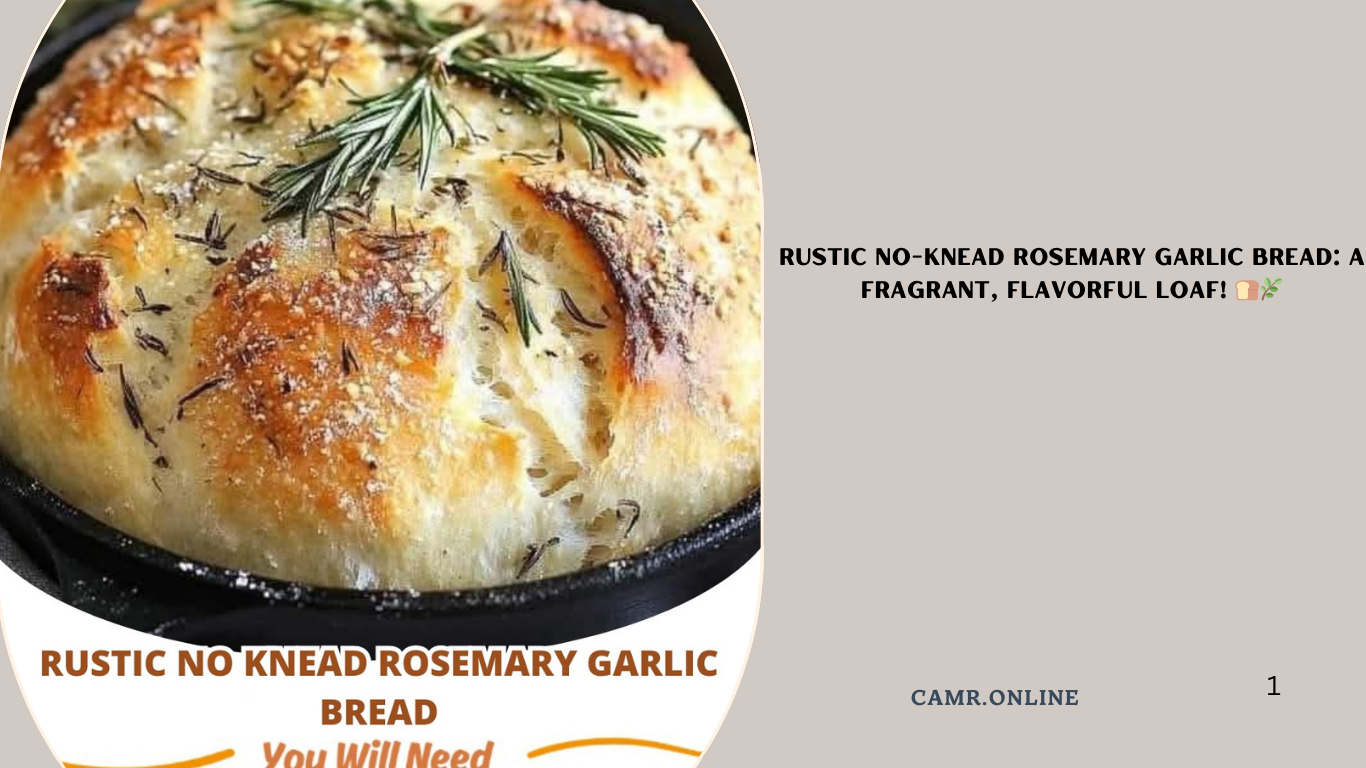If you’re searching for a simple yet impressive bread recipe that captures the essence of rustic charm, this Rustic No-Knead Rosemary Garlic Bread is your answer! With its fragrant rosemary, zesty garlic, and minimal effort required, this loaf delivers maximum flavor with no kneading involved. Perfect for family dinners, gatherings, or simply enjoying on its own, it’s an easy way to bring homemade goodness into your kitchen.
In this article, we’ll guide you step-by-step through making this delightful bread, share tips for success, and provide ideas for customization. Let’s dive in!
Why This Recipe Stands Out
Before diving into the details, here’s why this Rustic No-Knead Rosemary Garlic Bread deserves a spot on your table:
- No Kneading Required : The dough develops gluten naturally during a long rise, eliminating the need for manual kneading.
- Aromatic Flavors : Fresh rosemary and minced garlic infuse the bread with savory, earthy notes.
- Simple Ingredients : Made with just six pantry staples, this recipe comes together effortlessly.
- Versatile : Serve it as-is, toasted, or paired with soups, stews, or pasta dishes.
Now let’s explore the ingredients and instructions in detail.
Ingredients You’ll Need
For the Bread:
- 3 cups all-purpose flour
(Provides structure while keeping the bread light.) - 3 cloves garlic , minced
(Adds aromatic depth and savory goodness.) - 1 tablespoon finely chopped fresh rosemary , or more to taste
(Enhances the herbaceous profile; dried rosemary can also be used but adjust quantities accordingly.) - 1 ¼ teaspoons kosher salt
(Balances flavors and strengthens gluten development.) - ¾ teaspoon freshly ground black pepper
(Brings out the natural spiciness of garlic and rosemary.) - ½ teaspoon instant yeast
(The leavening agent that makes the bread rise beautifully.)
Optional Add-Ins:
- 1–2 tablespoons olive oil (for added richness)
- Grated Parmesan cheese (to sprinkle over the top before baking)
Step-by-Step Instructions
Step 1: Combine Dry Ingredients
- In a large mixing bowl, whisk together the all-purpose flour , kosher salt , black pepper , and instant yeast until evenly distributed.
- Stir in the minced garlic and finely chopped rosemary , ensuring they’re incorporated throughout the mixture.
Step 2: Add Water
- Gradually add 1 ½ cups lukewarm water to the dry ingredients, stirring with a wooden spoon or spatula until a shaggy dough forms.
- Cover the bowl with plastic wrap or a damp towel and let it rest for 5 minutes . This allows the flour to absorb moisture and simplifies shaping later.
Step 3: First Rise
- Leave the covered dough at room temperature for 12–18 hours . During this time, the yeast will activate, and the dough will develop a bubbly, slightly sticky texture.
- After rising, the surface should appear puffed and have small air bubbles.
Step 4: Shape the Dough
- Lightly flour your work surface and scrape the dough onto it. Sprinkle a little flour over the top if needed.
- Gently fold the dough in half several times to create tension, then shape it into a round or oblong loaf. Avoid overworking the dough, as it may deflate.
Step 5: Second Rise
- Place the shaped dough onto a piece of parchment paper or a floured proofing basket. Cover it again with a clean towel and let it rise for another 2–3 hours , or until doubled in size.
- Preheat your oven to 450°F (230°C) during the last hour of rising. If using a Dutch oven, place it in the oven to preheat as well.
Step 6: Bake Until Golden
- Carefully transfer the risen dough (still on parchment paper) into the preheated Dutch oven or onto a baking stone/pan.
- Score the top of the loaf with a sharp knife or lame for a rustic appearance and even baking.
- Bake for 30–35 minutes , or until the crust is golden brown and the bottom sounds hollow when tapped.
Step 7: Cool and Slice
Let the bread cool completely on a wire rack before slicing. This ensures the crumb sets properly and slices cleanly.
Tips for Success
- Use Lukewarm Water : Too hot, and it’ll kill the yeast; too cold, and it won’t activate properly. Aim for water around 95–105°F (35–40°C) .
- Don’t Overwork the Dough : Gentle handling preserves the airy texture developed during the long rise.
- Experiment with Herbs : Swap rosemary for thyme, oregano, or sage for different aromatic profiles.
- Add Extra Garlic : For garlic lovers, increase the amount or roast the cloves beforehand for milder sweetness.
Variations and Customizations
While the classic version is delicious, feel free to switch things up with these ideas:
- Cheesy Version : Sprinkle shredded mozzarella, cheddar, or Parmesan cheese over the dough before baking.
- Olive Oil Drizzle : Brush the top of the loaf with olive oil after scoring for extra shine and flavor.
- Spicy Kick : Stir in red pepper flakes or diced jalapeños for heat.
- Veggie-Packed Option : Fold in chopped sun-dried tomatoes, olives, or roasted bell peppers for added color and nutrients.
Serving Suggestions
This Rustic No-Knead Rosemary Garlic Bread pairs wonderfully with a variety of meals and drinks:
- Serve alongside soups, stews, or chili for a comforting meal.
- Offer it as part of a charcuterie board with cheeses, cured meats, and jams.
- Pair with red wine, sparkling water, or lemonade for refreshment.
- Freeze portions for later use—simply thaw and reheat when ready.
FAQs About Rustic No-Knead Rosemary Garlic Bread
Q: Can I speed up the rising process?
A: While faster rises are possible, the long fermentation enhances flavor and texture. For quicker results, use warm water and let the dough rise in a slightly warmer environment (about 75–80°F / 24–27°C ).
Q: What if I don’t have a Dutch oven?
A: Use a baking stone or regular baking sheet. To mimic the steam effect of a Dutch oven, place a shallow pan of water in the oven while baking.
Q: How long does this bread stay fresh?
A: Store leftovers in a paper bag at room temperature for up to 2–3 days . Freeze slices for longer storage.
Health Benefits of This Bread
While indulgent, there are ways to make this bread slightly healthier without sacrificing taste:
- Whole Grain Flour : Replace part of the all-purpose flour with whole wheat flour for added fiber. 2 Fresh Herbs : Rosemary and garlic offer antioxidants and anti-inflammatory benefits.
- Portion Control : Enjoy one or two slices per serving to savor the flavors while keeping portions reasonable.
Conclusion
This Rustic No-Knead Rosemary Garlic Bread proves that great bread doesn’t require complicated techniques or endless hours of work. By following our detailed recipe and expert tips, you’ll be able to create a loaf that rivals anything from a bakery—all with minimal effort.
So gather your ingredients, fire up the oven, and enjoy the satisfaction of serving something truly special. Happy baking—and happy eating! 🍴✨







